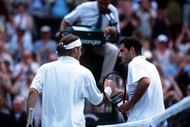Every streak has an end
In an age when our perceptions of the world around us are being reshaped with each passing tangible instant, fourteen years, it would be fair to surmise, constitutes a veritable lifetime. Thus, to wind our clocks back all the way back to 2001, would not only be a journey through the endless abyss of time, but also through a labyrinth of changes that have unravelled in the period and have brought us to where we are today.
But, what occurred 14 years ago? Why is it that the year, in the collective consciousness of the people across the globe, is perceived as a watershed? One needn’t wait for a historian to produce the answer; everyone and his neighbour are in possession of the answer to that question: 9/11. The terrorist attack on the World Trade Centre in New York, Unites States of America and the unsavoury consequences that it triggered in its wake, have been, indelibly engraved in the collective memories of people. However, those who religiously followed the game of tennis are likely to remember that year for reasons much different than the cataclysmic explosion that brought down one of the greatest marvels of modernist architecture.
Pete Sampras, heading into Wimbledon 2001, had, under his belt 13 Grand Slam titles, of which seven had been earned, at the expense of some of the best grass-courtiers such as Tim Henman, Patrick Rafter among others, at ‘The Championships’ in Wimbledon. ‘Pistol Pete’, as he was rightly called, had been, in the last decade of the 20th century, an insurmountable barrier, at the reef of which, some of the game’s greatest champions had floundered.
His invincibility at Wimbledon, was accepted, without raised eyebrows and, in ’01, it seemed as if no earthly force could halt Sampras from emulating Borg’s feat of five straight Wimbledon titles. It was against such a backdrop that Roger Federer arrived, who, with telluric fury, stormed Sampras’s citadel and showcasing to the world, that the American ace, too, was, after all human. Sampras’s defeat at Wimbledon sent shockwaves through the tennis community; it marked the end of one of the most glorious chapters in Wimbledon’s history.
Nadal’s domination on clay is starting to wither
14 years on, it is hard to escape a sense of déjà vu, as we see a visible ebb in Rafael Nadal’s prowess on clay. The Spaniard, whose domination at Roland Garros has been more absolute than Sampras’s ever was at Wimbledon, is looking more vulnerable than he ever did than in recent memory, on the surface, where the very prospect of his defeat a few years ago, would have sounded ludicrous. Beginning in April 2005 and till May ’07, Nadal won a whopping 81 matches on clay, before the juggernaut was halted by Federer.
Over the last few years, although Nadal’s domination on clay hasn’t been as clinical, the French Open has continued to remain his bastion, one that has withstood forces as supreme as Novak Djokovic. While Nadal has repeatedly shown that he is more than capable of shaking off sluggish starts to emerge victor in Paris, his incredible run in 2013, when he returned from 222 days of injury, being a case in point, he has seldom looked as vulnerable on clay as he does today.
So nightmarish has Nadal’s 2015 season been thus far that the Spaniard admitted that he wasn’t a favourite to win, leave alone the French Open, but no tournament this year. While he has sporadically shown glimpses of his incredible talent, they haven’t really given his fans plenty to cheer about. His only success this year came at the Argentina Open, a relatively low-key event, where he beat Juan Monaco in the title clash.
The season has, otherwise, been nothing short of a protracted nightmare. Starting with his quarter-final loss in the Australian Open to Tomas Berdych in straight sets to his third-round loss at the Barcelona Open, an event which he has won a staggering eight times, to Fabio Fognini, Nadal would, if given a choice, prefer to obliterate the season thus far from his memory.
The only performance which he can take heart from came at the Monte Carlo Masters, where he advanced till the semi-finals, before coming undone against his nemesis, Djokovic.
Other contenders to the crown
It is little wonder then, that experts and former players across the globe have begun composing epitaphs to Nadal’s domination on clay. It is not just the decline in Nadal’s form that has brought about such a change in the collective outlook of the tennis community. Nadal’s plummeting fortunes have been invariably accompanied by the emergence of players, who are now convinced that the Spaniard is no longer indestructible. Players like John Isner, whom Nadal had a hard time getting past at the Monte Carlo Masters and Milos Raonic, apart from the usual suspects (Djokovic, Andy Murray), are bound to fancy their chances against the nine-time French Open champion this time around.
Roland Garros is Nadal’s citadel, one which has been breached only once in the last ten years and the Spaniard will, despite his indifferent form this season, will hope to guard it, albeit against overwhelming odds, this time around as well.
Who Are Roger Federer's Kids? Know All About Federer's Twins

